
Under Wraps
TSA aims to get tough—and consistent—on one aspect of air security
- By Megan Weadock
- Feb 03, 2010
Since 23-year-old Nigerian Umar
Farouk Abdulmutallab attempted
to bomb a Northwest
Airlines flight on Christmas Day, the
Transportation Security Administration
has hurriedly sought to seal the
gaps in airline security that still exist
in the post-9/11 world.
Just after the New Year began, the
U.S. government implemented a barrage
of new measures, including mandatory
full-body, pat-down searches
to U.S.-bound travelers from Yemen,
Nigeria, Saudi Arabia and 11 other
countries. TSA also added dozens more
names to its no-fly and watch lists.
In a Jan. 5 speech, President Barack
Obama stressed the importance of aircraft
security in today's climate of fear
and terrorism.
"We face a challenge of the utmost
urgency," he said. "As we saw on Christmas,
al-Qaida and its extremist allies
will stop at nothing in their efforts to
kill Americans. We are determined not
only to thwart those plans but to disrupt,
dismantle and defeat their networks
once and for all."
The Cargo Question
Although passenger security is most
often in the national spotlight, cargo
security is just as important. That's why
TSA mandated that 50 percent of all
cargo carried aboard narrow-bodied
passenger aircraft had to be screened
for explosives by February 2009. Now,
air carriers, airports and freight forwarders
are preparing for the next stage
of the requirement, which says 100
percent of cargo that goes aboard both
narrow- and wide-bodied aircraft must
be screened by August.
Prior to the new rules, only cargo
from unknown or new shippers had to
be screened.
Now, companies like Jetstream
Freight Forwarding, a TSA-certified
cargo screening facility based in Seattle,
will have to screen all cargo that it places
on aircraft. The company, which ships
time-sensitive cargo around the world,
has installed a HI-SCAN 100100T-2is
X-ray system from Smiths Detection.
Staff will primarily use the explosives
detection scanner to screen perishables
from local growers in the Pacific Northwest
and California.
The HI-SCAN 100100T-2is is a medium
aperture X-ray inspection system
that is specially designed for screening
oversized baggage and bulky freight.
Mark Laustra, vice president and
general manager of the homeland security
division at Smiths, said the new
inspection system will save Jetstream
untold amounts of time.
"Without this equipment, you had
to use a K-9 team to inspect the cargo,
or you had to open the box manually,"
he said. "What the X-ray brought to
them is speed, because now all you have
to do is drop the box on the conveyor, it
goes through, you get an image, and the
screener or operator interprets the image
to see if there's anything that could
be dangerous, and they go from there."
The scanner provides dual views of
objects—from the side and the top—enabling reliable examinations of tightly
packed freight in a single pass. This
shortens inspections times to three to
five seconds on average, Laustra said.
For a freight forwarder that deals with
perishables such as flowers and fruit,
fast inspection times are absolutely key.
"That's why this type of cargo is
placed aboard aircraft and not seagoing
vessels or trucks—it has to move
quickly," Laustra said. "And if you're
shipping food or any kind of pharmaceuticals,
for example, you want to get
your cargo to the destination quickly.
So speed is of the essence, and that's
what X-ray provides.
"The dual-view X-ray further expedites
the scanning process by enabling
screeners to pinpoint foreign objects
in a parcel from two directions. If a
screener sees something of interest,
they now have the coordinates of whatever
is inside the parcel."
Bryan Jennings, president of Jetstream
Freight Forwarding, said the
HI-SCAN 100100T-2is will be a perfect
fit for the company's needs.
"With the volume of shipping we
do, the dual-views make the scanning
process more efficient and faster than
ever, allowing us to meet both our customer's
critical deadlines and the TSA's
CCSF requirements," he said.
Calm in the Storm
For travelers flying into the United
States, the first few weeks of 2010 was
a mess of inconsistent screening procedures,
confusion and, more than anything,
waiting. The news media and
blogosphere were in an uproar about
the terrorist attempt on Christmas
Day and the future of airport security.
Meanwhile, fury continues to grow over
one of the more popular cutting-edge
screening methods, millimeter wave
technology, which the ACLU calls a
"virtual strip search."
While TSA walks a fine line between
security and privacy for passengers, the
group seems to have simplified cargo
security as much as possible. By August,
100 percent of air cargo will be
screened—much of it by passing through
reliable and fast X-ray systems.
In the midst of all the confusion,
frustration and inconsistency of passenger
air security, at least we can
rest easy knowing that cargo security is
under wraps.